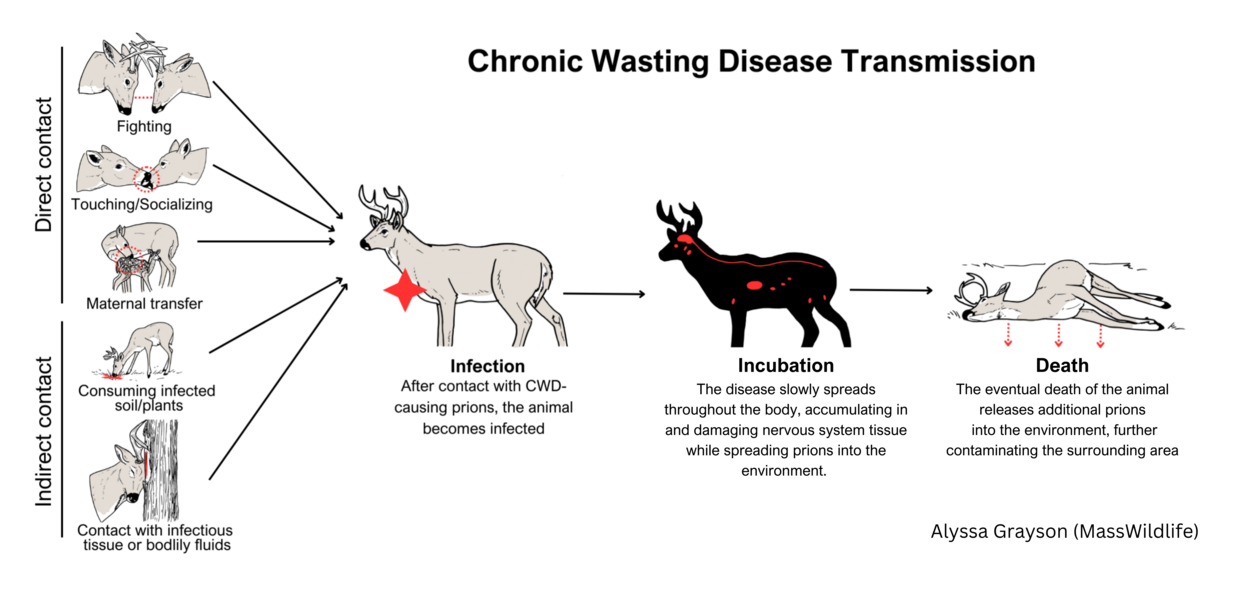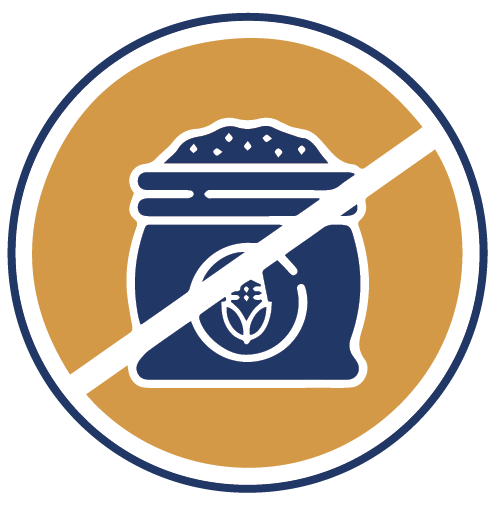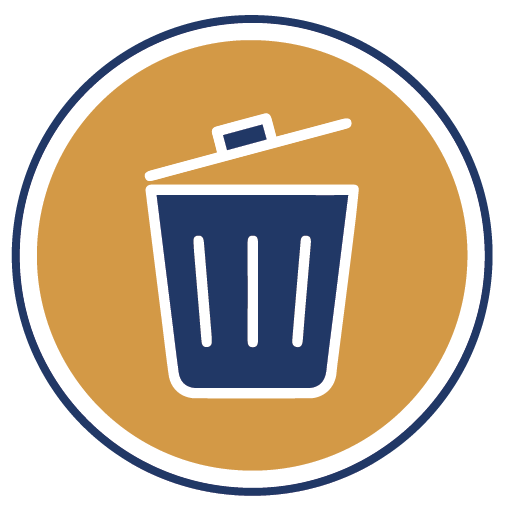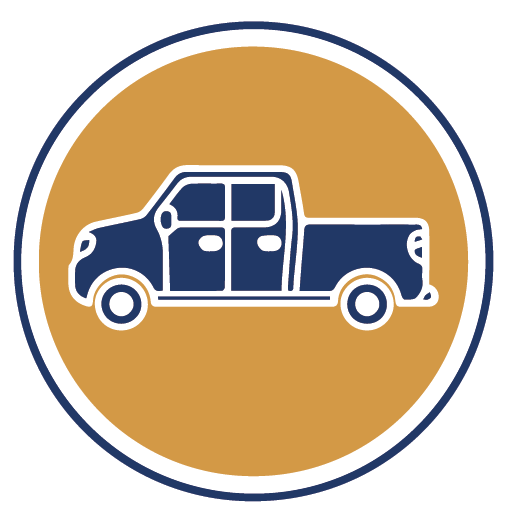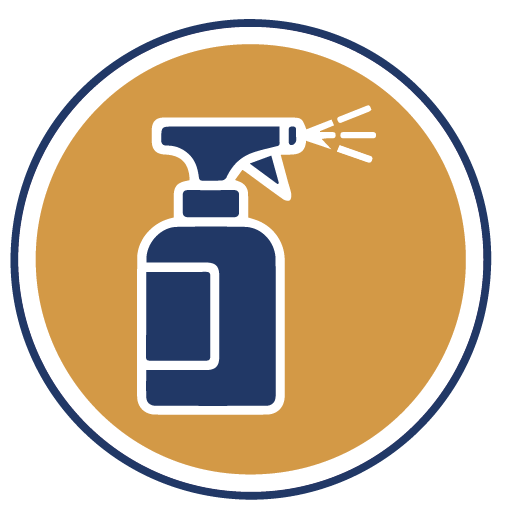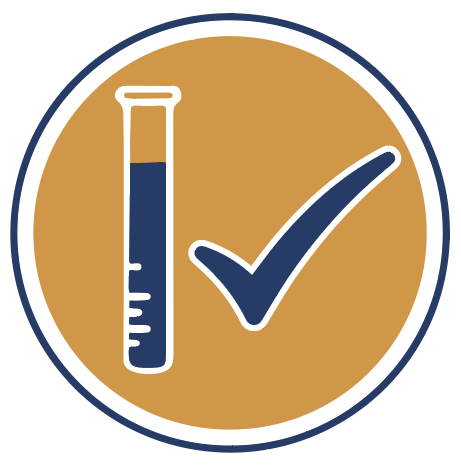Learn about CWD
What is chronic wasting disease (CWD)?
CWD is a fatal disease of the brain and nervous system. CWD kills cervid species (members of the deer family) including white-tailed deer, moose, mule deer, elk, and caribou.
Has CWD been found in Massachusetts?
At this time, there is no evidence suggesting CWD is present in Massachusetts. Once CWD is detected in an area, it is nearly impossible to eradicate. For this reason, keeping Massachusetts CWD-free is the best strategy to avoid the loss of mature deer, particularly bucks.
See the CWD map section for a North America map of states/provinces that are confirmed with CWD.
Why is CWD a problem?
CWD can have long lasting impacts on both the environment and the economy. CWD is a preventable disease that, if introduced, can gravely affect wildlife population health. When CWD prevalence is high, there can be shifts in the population’s age structure, where there are more young individuals and fewer mature deer. Additionally, studies have shown that CWD prevalence can reduce hunter participation, which can impact the outdoor sports industry and lower hunting license and permit sales. This reduces the funding for state wildlife agencies to conduct wildlife conservation and management. The disease can also be expensive to manage, with an annual cost for CWD positive states averaging around $773,000 in 2021 (Thompson and Mason, 2022).
What causes CWD? How is CWD spread?
CWD is caused by a misfolded protein, called a prion, that damages nervous system tissues. Prion diseases are not caused by viruses, bacteria, or parasites. Prions accumulate in the brain, spinal cord, and lymph nodes of affected animals, giving these tissues a sponge-like texture.
These proteins are infectious and can be transmitted between deer during socializing or fighting. Prions are shed through bodily fluids like urine, feces, and saliva. Transmission can also occur when deer make contact with contaminated plants or soil or when they make contact with bodily fluids or tissues while scent marking. Once in the environment, prions can persist and remain infectious for more than 15 years.
Can humans get CWD?
While to date, there have been no known cases of humans contracting CWD, the Centers for Disease Control and Prevention advises against eating animals that have tested positive for CWD. Unlike other diseases, cooking meat thoroughly does not destroy prions. To avoid the risk of CWD transmission, wear gloves while field dressing, minimize contact with the brain and spinal cord when field dressing, and don’t eat the brain, eyes, spleen, tonsils, or lymph nodes.*
*Normal field dressing and deboning will remove most, if not all, of these body parts. Cutting away all fatty tissue will remove remaining lymph nodes.
How can you tell if a deer or moose is infected with CWD?
There is no way to confirm that an animal has CWD by observation alone. It typically takes over 18 months for signs of CWD to appear, so infected animals can appear healthy. Signs of CWD are similar to those caused by other common illnesses or injury. In rare, advanced cases, some animals may show signs of disease including disorientation, drooping head, drooling, and weight loss. Asymptomatic deer still spread prions into the environment.
Currently, the only definitive way to diagnose chronic wasting disease is through tissue analysis done in a certified lab. This testing requires lymph nodes and/or brain stem samples, which must be collected after a deer has died.
Can CWD be treated?
There is currently no cure for CWD. When an animal contracts CWD, it is always fatal.
What is MassWildlife doing about CWD?
MassWildlife regulates the importation of cervids and their parts across state lines which helps prevent the spread of disease. Additionally, MassWildlife biologists collect lymph node samples for CWD testing from hunter-harvested deer for ongoing surveillance. At this time, MassWildlife cannot accept individual testing requests. There are private commercial services available for CWD testing but they charge fees and usually don’t use validated tests following the USDA National Veterinary Services Lab requirements.
Go to the Surveillance and prevention section to learn more.
Prevent the spread
| Don’t feed deer. Supplemental feeding, mineral licks, and bait sites cause healthy and sick animals to gather in one place. This increases the likelihood of spreading diseases like CWD. | |
| Dispose of harvested carcass parts properly. Dispose of carcass parts in a landfill or in the area near where the deer was harvested. Always follow state and local guidelines for proper carcass disposal. | |
| Debone carcasses before transport between states. Limit the movement of carcass parts to reduce the risk of spreading disease. Bringing whole carcasses or high-risk parts into Massachusetts from other states could not only unknowingly spread CWD into Massachusetts – it is also illegal. | |
| Use synthetic scent products. Urine of infected deer can contain CWD-causing prions that stay in the environment for many years. Deer may still be infected even if they appear healthy, so “CWD-free” labels on urine-based lures may not be reliable. This risk is present for all deer-derived lures and attractants. | |
| Opt-in to CWD testing. MassWildlife biologists collect samples for CWD testing from hunter-harvested deer at check stations. Hunter participation is crucial to CWD surveillance in Massachusetts. |
When hunting outside of Massachusetts
Know before you go. It is the responsibility of all hunters to stay informed about the current CWD status of any jurisdiction where they plan to hunt. Regulations in or near areas where CWD has been detected can vary significantly and change frequently. Check updated state and local resources before your hunting trip to ensure you’re following the most current guidelines.
When hunting out of state, do import:
- Deboned meat
- Cleaned skullcaps
- Hides without the head
- Fixed taxidermy mounts
When hunting in any state, Canadian province, or country outside of New England (Connecticut, Maine, Massachusetts, New Hampshire, Rhode Island, and Vermont), don't import:
- Whole carcasses of any member of the Cervidae (deer) family
- High-risk parts (head, brain, spinal tissue, or bones) of any member of the Cervidae (deer) family
CWD map
Blue states/provinces are confirmed with CWD as of July 2025.
Hunters harvesting cervids from any of the confirmed states/provinces above must follow regulations regarding the processing and transportation of deer parts across state lines. Hunters that do not follow out-of-state guidelines may unknowingly bring CWD into Massachusetts.
Surveillance and prevention
Keeping Massachusetts CWD-free is a priority for MassWildlife. The agency is involved in regional efforts to develop educational materials, share testing results, and optimize surveillance to prevent the spread of CWD across North America.
Surveillance: While new methods are being developed for testing on live deer, currently CWD tests can only be conducted on dead deer. MassWildlife biologists collect samples for CWD testing from hunter-harvested deer at check stations and from deer exhibiting suspect behaviors. MassWildlife has joined the Surveillance Optimization Project for CWD (SOP4CWD). This project allows states to share data and manage testing results.
Regulations: MassWildlife prevents the spread of infected deer entering Massachusetts by regulating the importation of deer harvested in other states. MassWildlife also maintains regulatory control over the captive cervid industry in Massachusetts by enforcing bans on all captive deer.
